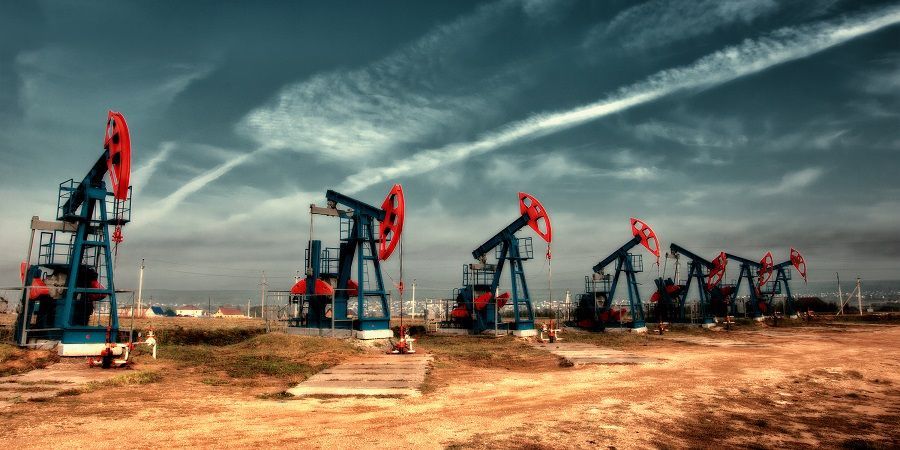Economists have credited Canada for making sound tax and interest rate decisions that will help lift the country from its small recession. If the U.S. economy recovers in the second half of 2002, as many predict, the Canadian economy is predicted to grow by 1.1% in 2002.
,Canada was the fifth-largest energy producer in the world in 1999, behind the United States, Russia, China, and Saudi Arabia. Over the past two decades, Canada has become a significant net energy exporter. In 1999, about 30% of Canadian energy production was exported, with the United States by far its main customer. From January-November 2001, the United States imported more oil (including crude oil and petroleum products) from Canada than from any other country. The United States consumed 3.155 trillion cubic feet (Tcf) of Canadian natural gas in the first eleven months of 2001, with 93% of total U.S. gas imports coming from Canada. In 1999, about 36% of Canada's primary energy production was natural gas, followed by oil (23%), hydropower (20%), coal (11%), and nuclear power (4%). Over two-thirds of Canada's energy is produced in the province of Alberta.
Canada also is a significant energy consumer and a member of the International Energy Agency (IEA). It was the world's sixth-largest energy consumer in 1999, roughly on par with India in terms of total energy consumption.
The Canadian energy industry is undergoing a period of reorganization, with consolidation in the oil and natural gas sectors and privatization in the electricity sector. While geography inhibits the development of a national electricity market within Canada, there is significant trade with the United States and potential for strong north-south regional markets, involving several Canadian provinces and adjacent U.S. states.
,
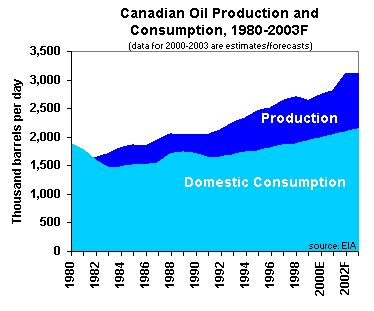 Canada has proven conventional oil reserves of 4.4 billion barrels, as of January 2002, a 152 million barrel increase over January 2001 levels. Oil production averaged 2.8 million barrels per day (bbl/d) during 2001, with estimated consumption of 2.0 million bbl/d. The province of Alberta, located in western Canada, is by far the country's leading oil producer. While Alberta's light oil reserves are declining (the province now contains an an estimated 45% of the country's light oil reserves), there are huge oil sands deposits. Meanwhile, projects and potential projects in other provinces are shifting the oil industry focus to include the eastern and northern parts of the country.
Canada has proven conventional oil reserves of 4.4 billion barrels, as of January 2002, a 152 million barrel increase over January 2001 levels. Oil production averaged 2.8 million barrels per day (bbl/d) during 2001, with estimated consumption of 2.0 million bbl/d. The province of Alberta, located in western Canada, is by far the country's leading oil producer. While Alberta's light oil reserves are declining (the province now contains an an estimated 45% of the country's light oil reserves), there are huge oil sands deposits. Meanwhile, projects and potential projects in other provinces are shifting the oil industry focus to include the eastern and northern parts of the country. Canada is a major source of U.S. oil imports. From January through November 2001, the United States imported 1.8 million bbl/d of crude oil from Canada (1.3 million bbl/d of which was crude oil). This makes Canada the top petroleum supplier to the United States and the third-largest supplier of crude oil imports (behind Saudi Arabia and Mexico, and ahead of Venezuela). Canada has been the top supplier to the United States of refined petroleum products, including jet fuel, distillate, etc., in the last few years.
The Canadian oil industry is in the midst of consolidation, reducing the number of active companies. Companies operating in Canada include Exxon's Imperial Oil, Royal Dutch/Shell's Shell Canada, Petro-Canada, and Suncor. Two of the largest companies, Alberta Energy and PanCanadian, began merger discussions in January 2002. If the deal goes through, the new company reportedly will become the largest independent North American producer.
Exploration and Production
Western Canada, and more specifically Alberta, remains the premier energy producing region in Canada. The Western Canadian Sedimentary Basin, underlying Alberta, Saskatchewan, and part of the Northwest Territories, has been the main source of Canadian oil production for the last 50 years. An estimated 55% of Canada's conventional oil production in 2000 came from Alberta. Conventional oil production has been declining in the west as it has been rising in the east in the last few years. However, as east coast projects are more expensive and develop smaller reserves, focus is expected to shift back toward the western part of the country in coming years.
Exploration and production activity on Canada's east coast is focused on the Jeanne d'Arc Basin, offshore Newfoundland. The climate demands technologically advanced offshore oil platforms, able to withstand extremely cold temperatures and high winds, which add to production costs. The first project in the area, the Hibernia field, came onstream in 1997 and produces around 150,000 bbl/d of light, sweet crude. Hibernia was subject to repeated delays, and grants totaling about $625 million from the federal government helped the project progress. ExxonMobil is the operator, with joint venture partners Chevron Canada Resources, PetroCanada, Canada Hibernia Holding Corporation, Murphy Oil, and Norsk Hydro.
The second project in the Jeanne d'Arc Basin, Terra Nova, began production in January 2002 after several delays. Terra Nova is about 30 miles away from the Hibernia field. The field currently has a capacity of 110,000 bbl/d and is expected to produce for about 15 years. Terra Nova is owned by PetroCanada (operator), ExxonMobil, Husky Oil Operations, Norsk Hydro, Murphy Oil Company, Mosbacher Operating, and Chevron Canada Resources.
There are two more Jeanne d'Arc fields, White Rose and Hebron. The White Rose field is expected to be the third Grand Banks development, beginning production in 2004, although concerns remain that development will be prohibitively expensive. The field could reach a projected 90,000 bbl/d at peak production. Finally, Chevron Canada Resources decided in February 2002 to defer development at the Hebron field, for financial reasons. Hebron contains heavier oil than Hibernia and Terra Nova.
On the west coast, a provincial British Columbia agency plans to review a 30-year-old ban on exploration in the Pacific Ocean. The area near Queen Charlotte Island is thought to hold as much as 10 billion barrels of oil as well as significant reserves of natural gas. This has the potential to make the area a larger oil and gas producer than the Jeanne d'Arc Basin.
Synthetic Crude Oil
Much of the exploration in Alberta in coming years likely will be for heavy crude and oil sands, as conventional oil reserves are being depleted. Unlike conventional oil, oil sands are a mixture of bitumen, sand, water and clay. The bitumen, a thick and tar-like hydrocarbon, surrounds the sand and water. To develop oil sands, bitumen is separated from the sand, water and clay. Once separated, bitumen can be upgraded into a high-quality oil called "synthetic crude." One of the largest synthetic crude producers, Syncrude (a joint venture of Alberta Energy, Canadian Oil Sands Investments Inc., Conoco, Imperial, Mocal Energy, Murphy Oil, Nexen, and Petro-Canada), reported an average production cost of about $11.50/bbl in 2001.
Canada holds around 2 trillion barrels of oil sands. The Athabasca Oil Sands deposit, in northern Alberta, is one of the two largest oil sands deposits in the world (the other is in the Orinoco Belt, Venezuela). There are also oil sands deposits on Melville Island, in the Canadian Arctic, and there are three smaller deposits in northern Alberta.
Current output of synthetic crude and bitumen is estimated at 600,000 bbl/d. According to the Canadian government, synthetic oil and bitumen production is expected to reach 1.2 million bbl/d by 2010.
,
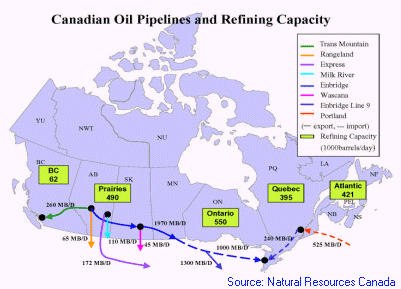 Although most Canadian oil is produced in western Canada (Alberta), oil is consumed primarily in central and eastern Canada. As a result, Canada exports oil from Alberta and imports oil on the east coast, explaining why Canada exports over 1 million bbl/d (gross) to the United States but has net exports of less than 1 million bbl/d. Furthermore, there is an extensive pipeline system to transport western oil to eastern Canadian and U.S. markets. There are two major pipeline networks. The first is Enbridge Pipelines Inc. (formerly Interprovincial Pipe Line-IPL), an 8,700-mile network of piping and terminals, delivering oil from Edmonton, Alberta, east to Montreal, Quebec and eastern Canada and the U.S. Great Lakes refineries and markets. It is one of the largest crude oil and petroleum liquids pipeline systems in the Western Hemisphere, and there are plans to expand its U.S. export capacity. The other major pipeline system is the Trans Mountain Pipe Line (TMPL), which delivers oil mainly from Alberta west to refineries and terminals in the Vancouver, British Columbia area, as well as to the Puget Sound area of Washington state.
Although most Canadian oil is produced in western Canada (Alberta), oil is consumed primarily in central and eastern Canada. As a result, Canada exports oil from Alberta and imports oil on the east coast, explaining why Canada exports over 1 million bbl/d (gross) to the United States but has net exports of less than 1 million bbl/d. Furthermore, there is an extensive pipeline system to transport western oil to eastern Canadian and U.S. markets. There are two major pipeline networks. The first is Enbridge Pipelines Inc. (formerly Interprovincial Pipe Line-IPL), an 8,700-mile network of piping and terminals, delivering oil from Edmonton, Alberta, east to Montreal, Quebec and eastern Canada and the U.S. Great Lakes refineries and markets. It is one of the largest crude oil and petroleum liquids pipeline systems in the Western Hemisphere, and there are plans to expand its U.S. export capacity. The other major pipeline system is the Trans Mountain Pipe Line (TMPL), which delivers oil mainly from Alberta west to refineries and terminals in the Vancouver, British Columbia area, as well as to the Puget Sound area of Washington state. BC Gas announced in January 2002 that it intends to build a new pipeline to transport bitumen from mines and and refineries near Fort McMurray to pipelines and processing plants in the Edmonton area. The proposed pipeline would cover about 320 miles and cost about $625 million. BC Gas predicts that if regulatory approval is granted in early 2003, the pipeline could come onstream by 2005.
,
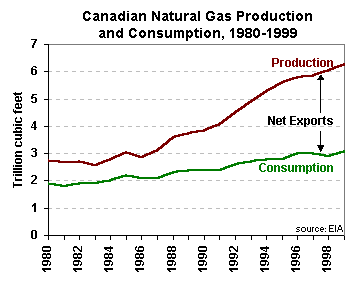 Canada holds about 59.7 trillion cubic feet (Tcf) of proven natural gas reserves. Canada currently produces about 6.3 Tcf of natural gas per year, making it the world's third largest natural gas producer (after the United States and Russia) and second largest natural gas exporter (after Russia). Canada's natural gas exports go almost exclusively to the United States. Canadian natural gas consumption is projected to grow significantly in coming decades, largely for use in electricity generation. As natural gas production and infrastructure grow, there is a potential for emergence of a unified North American natural gas market.
Canada holds about 59.7 trillion cubic feet (Tcf) of proven natural gas reserves. Canada currently produces about 6.3 Tcf of natural gas per year, making it the world's third largest natural gas producer (after the United States and Russia) and second largest natural gas exporter (after Russia). Canada's natural gas exports go almost exclusively to the United States. Canadian natural gas consumption is projected to grow significantly in coming decades, largely for use in electricity generation. As natural gas production and infrastructure grow, there is a potential for emergence of a unified North American natural gas market. Exploration and Production
Like the oil industry, Canada's natural gas industry is based primarily in Alberta, reaching into neighboring Saskatchewan, British Columbia, and the southern Northwest Territories. Saskatchewan is expected to become an increasingly important natural gas province in coming years. Atlantic Canada is a newer industry focal point. Nova Scotia's Sable Island and offshore Newfoundland hold significant natural gas reserves.
Sable Island Offshore Energy, a consortium led by Mobil Canada and including Shell Canada, Imperial Oil, Nova Scotia Resources and Mosbacher Operating, began production in January 2000. About 550 million cubic feet per day of natural gas is pumped from three reservoirs at Sable Island's Thebaud platform. Shell had originally estimated Sable reserves to hold 1.1 Tcf, but in January 2002 that estimate was revised downwards to 0.8 Tcf.
The Arctic Northwest Territories and the Yukon are thought to hold great potential for new gas discoveries. While the territories are unlikely to exceed Alberta's production, as Alberta becomes increasingly mature the territories represent a major potential new source of gas. Calgary-based Berkley Petroleum, Chevron Canada, and Ranger Oil all have made discoveries in the Northwest Territories. The Mackenzie Delta area of the Northwest Territories reportedly could hold as much as 65 Tcf of natural gas.
,
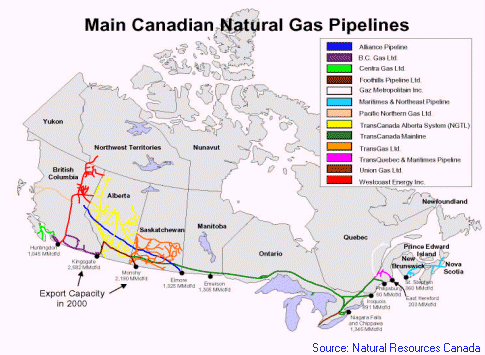 There has been considerable progress in recent years on natural gas interconnections between Canada and the United States. The Northern Border Pipeline, an extension of the Nova Pipeline, came onstream in late 1999 and connects to Chicago through the upper Midwest. The Maritimes and Northeast Pipeline came onstream in January 2000, running from Sable Island to New England, with further extensions into New England planned. In February 2002, Enbridge shelved plans to build a pipeline connection between Sable Island and Quebec.
There has been considerable progress in recent years on natural gas interconnections between Canada and the United States. The Northern Border Pipeline, an extension of the Nova Pipeline, came onstream in late 1999 and connects to Chicago through the upper Midwest. The Maritimes and Northeast Pipeline came onstream in January 2000, running from Sable Island to New England, with further extensions into New England planned. In February 2002, Enbridge shelved plans to build a pipeline connection between Sable Island and Quebec. The $2.5-billion Alliance Pipeline, at 1,875 miles, is the longest pipeline ever built in North America, and is designed to carry about 1.3 billion cubic feet per day (Bcf/d) of gas from western Canada (Fort St. John, British Columbia) to the Chicago area. The pipeline began commercial service on December 1, 2000. The U.S. utility Pacific Gas & Electric imports natural gas from British Columbia via the Alliance pipeline.
The Millennium Pipeline remains in the regulatory approval stage of development; it is slated to connect Canadian sources to southern New York and Pennsylvania. Indecision over the final route of the pipeline in New York currently is stalling progress.
Exploration and production activity in the Mackenzie Delta, Beaufort Sea, and Alaskan North Slope has sparked interest in an Arctic pipeline. Combined Alaskan and Canadian assets in the area stand at about 40 Tcf of proven reserves, with far more probable reserves. Alaskan, Yukon, and Northwest Territory governments all support different routes, with various companies vying for their chosen routes.
Low natural gas prices as of February 2002 appear to be having a negative effect on the prospects for Arctic pipeline development. BP, formerly one of the companies most publicly committed to an Alaska pipeline, now has stated that the pipeline is not a good project in the current price environment. However, in January 2002, the Mackenzie Delta Producers Group, led by Imperial Oil, announced that it is seeking regulatory approval the Mackenzie line, to connect to Alberta. TransCanada Pipelines and Enbridge, Canada's two largest pipeline companies, remain interested in building outlets for northern gas.
,Canada is a major coal producer and consumer, with estimated 1999 output of 79.9 million short tons (Mmst), consumption of about 63.4 Mmst, and reserves of 9.5 billion short tons. About 80% of Canada's coal exports are for metallurgical purposes, with the vast majority purchased by Japan (60%) and South Korea (16%). Alberta accounts for about half of Canada's coal production, while British Columbia and Saskatchewan account for about 30% and 15%, respectively. Bituminous coal makes up about half of Canada's coal output, with sub-bituminous (about one-third) and lignite the rest. Canadian coal consumption is primarily (87%) for electricity generation, with the remainder mainly used for steel-making.
,
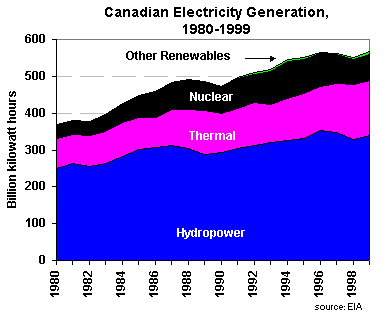 Canadian electricity generation in 1999 totaled 567.2 billion kilowatt hours (bkwh), of which 60% was hydropower, 26% was conventional thermal power (oil, gas, and coal), 12% was nuclear generation, and 1% was derived from other renewable sources. Canada was the largest producer of hydropower in the world in 1999, and hydro sources are not yet believed to be fully exploited. Trends in coming years are expected to favor thermal power generation, mainly from natural gas. The Canadian nuclear power industry has declined to 69.8 bkwh in 1999 since its peak of 102.4 bkwh in 1994. Ontario contains the bulk of Canadian nuclear capacity.
Canadian electricity generation in 1999 totaled 567.2 billion kilowatt hours (bkwh), of which 60% was hydropower, 26% was conventional thermal power (oil, gas, and coal), 12% was nuclear generation, and 1% was derived from other renewable sources. Canada was the largest producer of hydropower in the world in 1999, and hydro sources are not yet believed to be fully exploited. Trends in coming years are expected to favor thermal power generation, mainly from natural gas. The Canadian nuclear power industry has declined to 69.8 bkwh in 1999 since its peak of 102.4 bkwh in 1994. Ontario contains the bulk of Canadian nuclear capacity. Canada exported about 42.9 bkwh of electricity to the United States in 1999, mostly from Quebec, Ontario, and New Brunswick to New England and New York. Smaller volumes are exported from British Columbia and Manitoba to Washington state, Minnesota, California, and Oregon. There is considerable reciprocity between the Canadian and U.S. power markets, as the United States also exports smaller volumes of electricity to Canada.
Natural gas-fired power plant construction is on the rise in Canada, preparing for a three-fold increase in gas power generation in the next decade, as predicted by the Canadian Energy Research Institute. PanCanadian Petroleum, TransAlta, EPCOR, and ATCO Power are all in various stages of developing new (mostly cogeneration) gas-fired plants in Alberta and Saskatchewan.
Under Canada's constitution, electricity is primarily within the jurisdiction of the provinces. In most provinces, the bulk of generation, transmission, and distribution is provided by a few dominant utilities. Although some of these utilities are privately owned, most are owned by the provinces. There is also limited independent power producer (IPP) generation, mostly for sales to the larger utilities.
Alberta and Ontario, which together account for about half of Canada's electricity market, have introduced legislation to deregulate their power sectors. Alberta is much further along in the deregulation process. It was the first province to introduce privatization legislation in 1995, and a 1998 amendment to the original legislation allowed retail customers to choose their electricity suppliers beginning January 1, 2001.
Ontario introduced privatization legislation in 1998, and deregulation is set to commence in the province in May 2002. Ontario's Hydro One utility, the successor to the province's Crown monopoly Ontario Hydro, is slated for initial public offering (IPO) in 2002. It is expected to be Canada's largest-ever IPO.
Quebec and British Columbia do allow third party access to their electricity grids as the result of trade agreements with the United States, but neither province has plans to break up its utility monopoly.
Автор: Energy Information Administration

